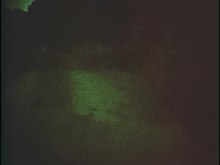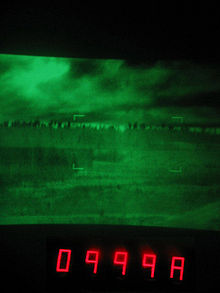Thermal imaging device (military)


Thermal imaging devices (WBG) are optical or optoelectronic night vision devices with a thermal imaging camera (also called thermal imager ).
Among other things, they are used in tanks and enable a combat vehicle for night combat.
A WBG is a passive night vision device, which differs from an active night vision device in that it does not require an infrared headlight.
history
The ability to fight at night and fight in poor visibility are desired by the military. Perceiving the environment in the dark without being seen replaces the battlefield lighting . Night combat capability is a military advantage.
At the time of the Cold War , there was a technological lead for some time on the part of NATO over the Warsaw parties . While residual light intensifiers with image intensifier tubes were still used in the east , the first complex passive thermal imaging devices were used in the west in order to be able to detect and fight targets even in complete darkness.
In 1971 , the military's first thermal imaging devices were ready for series production. But until the beginning of the 1980s, the NATO army was still predominantly equipped with active night vision devices such as periscopic IR rifle scopes that worked in the near infrared range from 0.76 to 1.20 micrometers . The Leopard 1 had a shooting light with a xenon lamp that could be switched from white light to infrared. The infrared radiation is invisible to the human eye, but not to the enemy's night vision devices.
The night rifle scope TPN-1 was used on the Soviet side for a long time. Here, too, targets were illuminated with an infrared spotlight in order to be able to fight them. The disadvantage of the IR target lights was, in addition to the ease of detection, also the inadequate splinter protection.
At the beginning of the development of the armored infantry troops of the German armed forces, only the platoon command tanks were equipped with WBG. The armored personnel carrier “Marder” experienced a considerable increase in combat value through the WBG.
The basic device of the high-resolution WBG-X had been equipped by the US company Common Modules (subsidiary of Texas Instruments ) since 1979 . From 2000 the WBG-X was replaced by the OPHELIOS system and later by ATTICA.
There are now cooled and uncooled thermal imaging cameras. Uncooled devices use bolometers - arrays . Cooled thermal imaging devices can resolve small differences in temperature, but they are more expensive, heavier and not immediately operational.
technology
Thermal imaging devices work like thermography and have a thermal imaging camera . WBG register the heat radiation in the middle infrared, i. H. in a range of 3 to 14 micrometers wavelength. In contrast to residual light amplifiers and infrared vision devices, a WBG is therefore able to convert temperature differences into a thermal image even in complete darkness and without lighting (i.e. passive). Thermal imaging devices reproduce the heat signature of people and vehicles at night and with poor visibility (fog, smoke development during a battle).
The functioning of a WBG is linked to temperature differences. The images are displayed in false colors or grayscale . Reflections from the sun, fires on the battlefield, or snowfall can seriously affect this.
Glass is opaque in the mid-infrared, which is why, for example, people behind a windshield cannot be seen.
Even in daylight, the WBG often provides additional information and therefore often remains switched on.
Types / models
WBG-X
In 1981 the first generation of the WBG was developed by the Hensoldt company , Optronics division (formerly Zeiss-Eltro Optronic ) and introduced to the combat troops of the German armed forces as WBG-X. With the WBG-X battle tanks Leopard 1 , Leopard 2 , armored personnel carriers Marder , Spähpanzer Luchs and other combat vehicles of the army were equipped to be able to fight at night.
Other areas of application were marine (MEOS, EOBA, SERO) and air force ( Hawk , Tornado ECR ).
Over 10,000 WBG-X were built. The model was replaced by more modern devices such as Ophelios and Attica and has not been produced since 2015 .
Thermal imaging devices built into tanks are mostly thermal imaging telescopic sights that are connected to the fire control system of the on-board cannon and can be operated independently by commanders and gunmen. The WBG-X has 4 to 12 times magnification, with an extension of up to 36 times.
After switching on, the WBG-X is ready for operation after ten minutes, because the image sensor made of cadmium - mercury - telluride (CdHgTe or MCT) must first be cooled down to an operating temperature of −196 ° C.
The WBG-X works at wavelengths of 8 to 14 micrometers and receives the heat radiation from the objects. Like all thermal imaging cameras, it does not require any lighting.
The WBG uses almost the same line pattern as the target optics in daytime operation (e.g. EMES PERI-R17). At the beginning of serving, gunmen or commanders usually use 12x magnification, which is then switched to 4x for wide-ranging observation of the battlefield.
The maximum reconnaissance range is about 3 kilometers.
The light-dark polarity of the display can be adjusted depending on the conditions of the observation environment. The image of the WBG is faded into the field of view of the day channel via an optical channel of an eyepiece assembly in order to achieve observation and fire control as under daytime conditions. A lever can be used to switch between daytime and thermal image channels.
The modular Zeiss WBX-X is optically connected to the commander's panoramic periscope Zeiss PERI R17. You can switch between a large field of view and a cutout for clear target recognition and identification.
The WBG-X had a power consumption of 180 watts, had a working temperature of −35 to +63 ° C and weighed around 18 kilograms with the mass of its basic device.
Switching on the WBG is part of the preparation for combat readiness in the tank. The thermal imaging device is ready for operation as soon as the cooling machine has cooled down the image sensor and a clear image appears.
The reconnaissance range of the WBG extends beyond the operational range of the on-board weapons. Shooters who are at a distance of 1500 meters can usually be easily recognized even when the turret rotates rapidly. To a certain extent, heat signatures can also be cleared up behind light cover. The identification of shooters, on the other hand, is usually only possible with daytime optics.
Battlefield observation from a position is one of the main tasks of the WBG. The day vision optics, on the other hand, are more used for target identification or for targets without a heat signature.
literature
- Harry Schlemmer: Seeing an Invisible World - The History of Thermal Imaging . ISBN 978-3-8132-0979-2 .
- James A. Ratches: Current and Future Trends in Military Night Vision Applications . Journal Ferroelectrics. Volume 342 - Issue 1. 2006.
Web links
- Vehicle optronics. Hensoldt product brochure
- Technology thermal imaging devices
- Prof. Dr. Jürgen Nolting. How does it work? How do thermal imaging devices actually work? DOZ optometry
- Omer Tsimhoni and Paul Green: Night Vision Enhancement Systems for Ground Vehicles: The Human Factors Literature. Technical Report UMTRI-2002-05 April, 2002
- Night Vision Use in the Military. Night Vision Optics.
Individual evidence
- ↑ WBG-X. Zeiss-Eltro Optronic. Fire Control Systems. Thermal imaging sight. Army Guide
- ^ Hans-Peter Lohmann, Rolf Hilmes: Marder armored personnel carrier. The technical documentation of the weapon system. Motorbuch Verlag, Stuttgart 2011, p. 100. ISBN 978-3-613-03295-8 .
- ↑ HDIR: Very-high-resolution thermal imager
- ^ Company information Zeiss Optronik: "Common-Modules-Wärmebildgeräte", 2003
- ↑ Technology thermal imaging devices
- ↑ Technology thermal imaging devices
- ↑ Innovation at HENSOLDT. Thermal imaging technology
- ^ Land / Optronics / Fire Control and Reconnaissance. Leopard Fleet Retrofits and Upgrades. Company Hensoldt
- ↑ Hans-Peter Lohmann: Spähpanzer Luchs: The technical documentation of the weapon system. Motorbuch Verlag, Stuttgart 2010, p. 104. ISBN 978-3-613-03162-3 .
- ↑ Other vehicles were M48 , M113 and Jaguar tank destroyers
- ↑ Although the inceptive heat-seeking device, the Danube River, dates back to 1944, large-scale production commences much later. 10,000+ WBG-X thermal imagers designed for Leopard 1, Leopard 2, Marder and Luchs armored vehicles are produced pursuant to the common module principle. Catalog from the Hensoldt company. 2014
- ↑ Airbus DS Optronics offers state-of-the-art retrofit gunner sights for armored vehicles. Company Hensoldt
- ↑ The fire control system of the Leopard 2 battle tank
- ↑ Zeiss thermal imaging devices see, recognize and aim at night and in bad weather. Advertisement from Zeiss. Herbert Wanner: Modern armaments: Necessary and desirable also for our army. Schweizer Soldat + FHD: independent monthly magazine for the army and cadres. Volume (Year): 57 (1982)
- ^ Hans-Peter Lohmann, Rolf Hilmes: Marder armored personnel carrier. The technical documentation of the weapon system. Motorbuch Verlag, Stuttgart 2011, p. 101. ISBN 978-3-613-03295-8 .
- ↑ TDv 1005 / 049-12 SPz infantry fighting vehicle Panzer Marder 1


